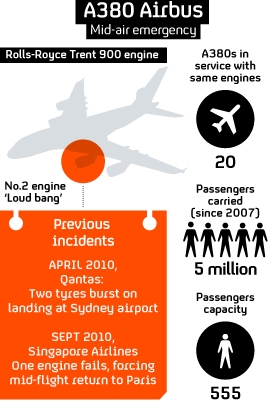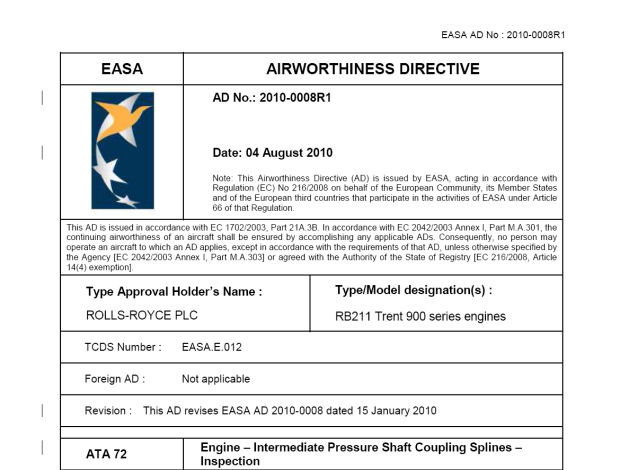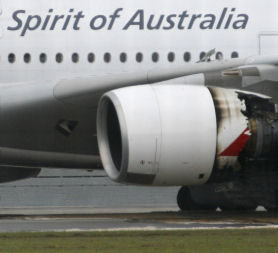Airbus engine failure warning weeks before Qantas scare
Exclusive: Channel 4 News reveals the Rolls-Royce engines used on the Airbus A380 were identified as “potentially unsafe” weeks before a Qantas jet was forced to make an emergency landing.
The double-decker Qantas plane made an emergency landing in Singapore after one of its engines shut-down in mid-air.
All 459 people on the “Superjumbo” plane, which was flying to Australia, were uninjured, and a Qantas statement said they were now investigating what caused the problems with the aircraft.
We are obviously taking this very seriously, because it was a significant engine failure. Qantas Chief Executive Alan Joyce
It has grounded its remaining Airbus A380 fleet while it works with Airbus and the engine manufacturer, Rolls-Royce, to find out the cause of the incident.
Singapore Airlines has also delayed all Airbus A380 flights.
Qantas Chief Executive Alan Joyce said: “We will suspend all A380 take offs until we are fully confident we have sufficient information about [flight] QF32… The A380 is a fantastic aircraft. This issue of an engine failure is one we have not seen before.
“We are obviously taking this very seriously, because it was a significant engine failure.”

While everyone, quite rightly, is warning against speculation over the cause of the engine failure that caused the Qantas A380 Airbus to make an emergency landing at Singapore, Channel 4 News can reveal only a month ago airlines were warned of a turbine problem with the Rolls-Royce Trent 900 engines used on the A380 planes now in service with Qantas, Singapore Airlines and Lufthansa, and which will power British Airways’ planes when they are delivered.
In August, the European Aviation Safety Authority (EASA) issued an Airworthiness Directive warning of increased wear on a coupling on the engine’s Intermediate Pressure shaft that “present a potential unsafe condition to the aeroplane”.
The coupling allows the axial setting of the turbine to be controlled and the directive says the increased wear would allow the Intermediate Pressure turbine to move rearwards which “would enable contact with static turbine components and would result in loss of engine performance with potential for in-flight shut down”.
That’s dry engineering-speak for a potentially catastrophic in-flight engine failure where turbine blades, spinning at high velocity, smash into the casing or other solid parts of the engine and shatter explosively, much as passengers on board the Qantas flight have described. Fire, from escaping fuel and oil is often the result.

See the Airworthiness Directive in full here
'I was just waiting for us to start going down'
Passenger Tyler Wooster, from Melbourne, Australia, told Channel 4 News: "All of a sudden I heard a big shotgun-like bang, just a massive bang. It wasn't like a fire, it was just like the top split open and it became a little smoky. I could see the wires hanging out, it didn't look good.
"Everyone was shocked, everyone was wondering what was going to happen. I was just waiting for us to start going down. I could see the skin peeling off the wing - that was pretty nerve-wracking.
"After about three minutes the pilot told us we were running on three engines and everything was fine. Then we had to fly around in circles to get rid of fuel.
"When we landed we finished right on the end of the tarmac - it was a real uncomfortable landing. When we landed everyone was cheering and clapping."

Modern aero engines, of course, are designed to withstand such failures and contain the blow-out and the shattered turbine blades and, in the case of Qantas Flight QF32 that seems to have been successful.
The EASA ordered more frequent inspections of the critical parts and corrective action where necessary.
Air accident investigators will inevitably want to inspect these parts of the damaged engine closely, and will check Qantas maintenance records to confirm the inspections had been carried out.
Investigators will be trying to establish exactly what happened to the Qantas engine and if a problem such as the one identified here could have occurred. Rolls Royce declined to comment when contacted by Channel 4 News.
A top aircraft engineer in Australia told Channel 4 News that the “most likely scenario”, based on the amount of information available so far, was a problem with the engine.
Paul Cousins, president of the Australian Licensed Aircraft Engineers Association, said: “The pictures we have seen suggest, it looks like a turbine disc has given way in the rear of the aircraft and broke off and looks like that came out and caused panels of the engine to come off.
“That would make that kind of bang that passengers heard.”
What the captain said - announcement to passengers:
"I do apologise, I'm sure you're aware we have a technical issue with our number two engine.
"We have dealt with the situation - the aircraft is secure at this stage. We're going to have to hold for some time while we lighten our load by dumping some fuel and [there are] a number of checks we have to perform.
"I'm sure you are aware we're not proceeding to Sydney at this stage, we're making a left turn now to track back towards Singapore.
"As we progress with this we'll keep you informed. At this stage everything is secure - the aircraft is flying safely. We'll get back to you very shortly with further information."
"Thank you for your patience."
Mr Cousins said the damage on the aircraft did not tally with other potential causes – such as a bird striking the plane.
“Both Rolls Royce and Airbus will be taking a keen interest in what has gone on, and Qantas will make sure they have a keen interest, because when something like this happens it damages the reputation of all three organisations, and if there is a manufacturing defect it needs to be fixed,” he added. He also said maintenance was an issue.
“It’s only an initial observation but we also would have concerns over maintenance,” he said. “We would want to know the maintenance history of that aircraft.”